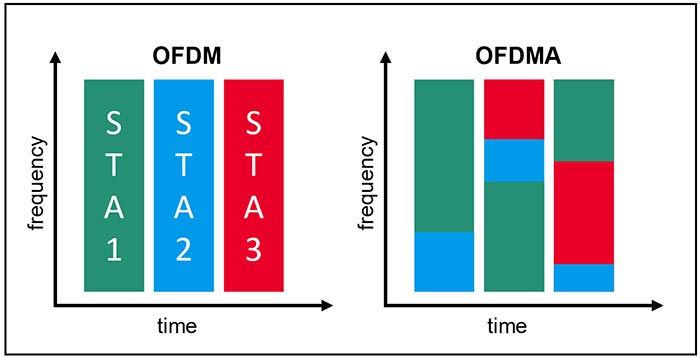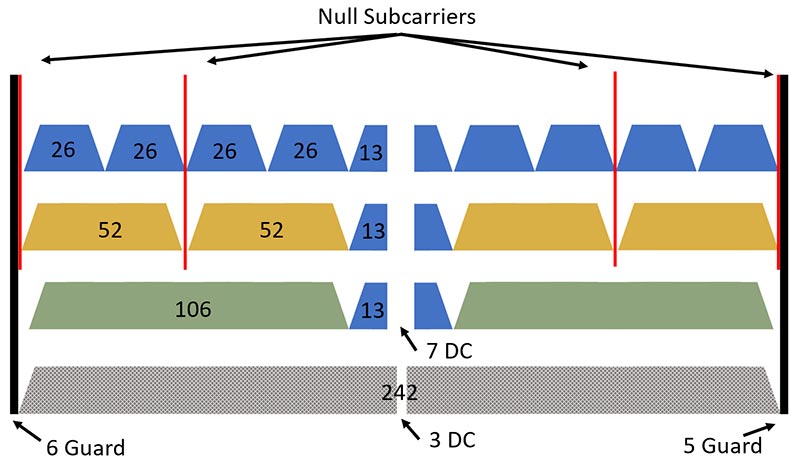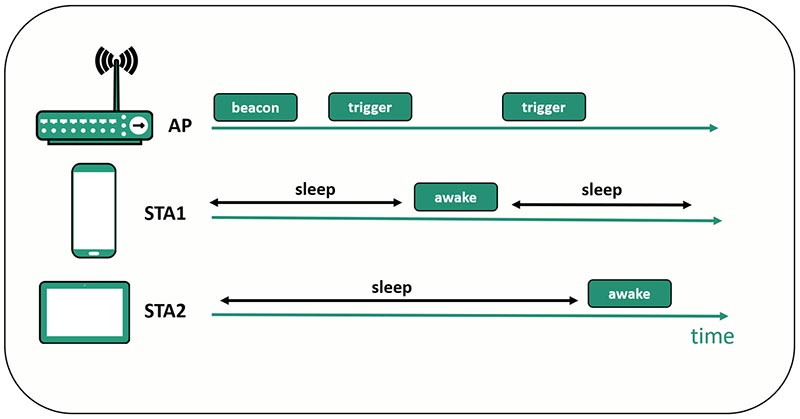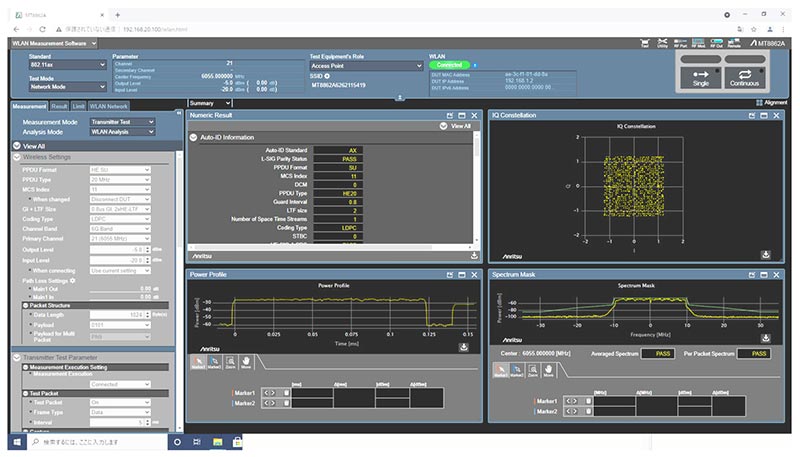The latest version of the WLAN (Wireless Local Area Network) is Wi-Fi 6, the sixth (commercially) successful release of the IEEE 802.11 standards. Although officially known to industry by its IEEE standard designation, the term Wi-Fi 6 is more familiar to consumers.
The legacy standard, most notably Wi-Fi 5, can deliver higher data rates to a user but only under ideal “laboratory” conditions. New features in Wi-Fi 6 make the technology more robust and get closer to the promised data rates.
One of the most prominent upgrades is the use of orthogonal frequency-division multiple access (OFDMA) technology. Similar to cellular LTE technology, users are assigned allocated time slots in specific frequencies for their radio transmission. This manages communication between an Access Point (AP) and Stations (STAs) much more efficiently than with the previous technique, OFDM (Orthogonal Frequency Division Multiplexing).
OFDMA also channelizes the available frequencies differently. With the legacy standards, the minimum channel width is 20 MHz. In some cases, two adjacent channels can be linked, shifting the carrier frequency to the middle of the two channels. This allows channel widths such as 40 MHz, 80 MHz and 160 MHz, allowing higher throughput rates at the cost of larger frequency occupation.
In Wi-Fi 6, the smallest available unit for data transmission is called a “Resource Unit” (RU). The RU may contain 26, 52, 106, 242, 484 or 997 tones (subcarriers). Given the subcarrier spacing in Wi-Fi 6 to be 78.125 kHz, the minimum RU size occupies around 2 MHz of the frequency range, allowing spectrum resources to be scaled up more than with the legacy standards.
As well as improved spectrum efficiency, there are also more transmitted bits per transmitted symbol, thanks to the data subcarrier modulation – 1024QAM. This modulation maps 10 bits of message to one transmitted symbol (2^10=1024). This gives Wi-Fi 6 higher data rates than legacy standards. The duration of symbols has also increased by four times due to denser subcarrier spacing. Put simply, the smaller the signal is in the frequency domain, the longer the signal is in the time domain and vice versa. This improves robustness, particularly in outdoor use.
Wi-fi 6 newly addresses Internet of Things (IoT) use cases. In the IoT world, low energy consumption is critical. IoT devices often come with built-in batteries which cannot be replaced – swapping them means destruction of the device. Therefore, it is important to have communication protocols that offer built-in power saving features.
One such feature in Wi-Fi 6 is the smallest 2 MHz wide RU. Using smaller frequency spectrum to send a signal requires less energy than larger frequency spectra – e.g., the 20 MHz wide legacy channel. Energy is therefore saved because of the lower number of subcarrier frequencies used.
Another power saving feature incorporates schedules which allow a Wi-Fi 6 powered device to spend some time ‘asleep’. This feature is called Target Wake Time (TWT). In sleeping mode, wireless devices use minimum power. The device wakes up at a specific time and can then send information – the temperature in a room or to inform about missing medical supplies. Once the information is communicated, a WLAN device can go back to sleep mode.
Despite these advantages, large numbers of communicating WLAN devices can create mutual electromagnetic interference, reducing overall WLAN performance. This is partially mitigated by Wi-fi 6 using techniques such as dynamic OBSS Packet Detection (OBSS-PD), which adjusts different energy threshold values to detect the correct incoming signal.
However, the main reason for the interference is frequency band occupation. Until Wi-Fi 6, only two bands were defined: 2.4 GHz and 5.0 GHz.
These two bands were enough to handle the number of users and required data rates. To meet demand for higher data throughputs and reliability, a new 6 GHz frequency band has been proposed. The band starts at 5.925 GHz and goes up to 7.125 GHz, giving another 1200 MHz of spectrum.
Sites for Wi-Fi can vary in their signal transmission properties, with many variables affecting Wi-Fi performance. It’s important to choose the best spot for Wi-Fi antenna(s), taking account of materials which could block or absorb wireless signals.
Wi-Fi 6 performance can be measured using the Anritsu MT8862A WLAN tester. This provides a wide dynamic range allowing OTA (Over-The-Air) tests to measure the physical properties of a radio channel. It is also possible to perform IP data connectivity tests up to Wi-Fi 5 standard. Using this instrument, Wi-Fi performance can be optimized to ensure users receive a high QoE (Quality of Experience).
Companies can also test the interoperability of many wirelessly connected devices, testing multiple technologies in parallel to see how the quality of WLAN signals is affected. Alternatively, they can perform a receiver test (sensitivity test) where the power output of the MT8862A instrument is gradually lowered. Increasing Packer Error Rate and Frame Error Rate can tell a lot about the Device Under Test, or DUT, in a given environment. The connection with a DUT can be further degraded using a noise source and later analyzed.
The newly added Wi-Fi 6E support on MT8862A enables testing of the 6 GHz band, which brings its own possible sources of electromagnetic interference. As well as measuring the overall sensitivity on this band, it is still possible to do transmitter tests. The measurement of power, spectrum mask and modulation accuracy are clearly shown in the main window of the remote GUI (Graphical User Interface), with more detailed information of single measurements available in the Numeric Result window.
The remote GUI can also show more information about a connected DUT such as its MAC address, supported standards, supported MCS values and others. Within the GUI, it is also possible to choose the encryption type – WEP, WPA/WPA2-Personal/WPA3-Personal. An IP address of a DUT can be assigned either statically or dynamically thanks to a built-in DHCP server. Many more typical WLAN network parameters can be also selected within the GUI, such as SSID name and a password (if encryption is applied).
All the GUI steps can be further automated thanks to the remote-control interface, handy for when the automation of measurements is required. To achieve this automation, a user can purchase the official automation tools such as Smart Studio Manager (SSM) or Automation Test Software (ATS). More adventurous users can go even further and make their very own automation using scripting languages such as Python. Users need to find the right set of commands and queries to be communicated with MT8862A. All these possibilities make the Anritsu MT8862a WLAN tester an ideal companion in the lab.
For mass production testing of WLAN connected devices there is a better match, the MT8870A universal wireless test set, which offers a quick and easy way to verify the radio frequency properties of wirelessly connected devices. As well as Wi-fi 6 technology, it covers others such as GSM, WCDMA, LTE, 5G NR and many more. Only the chipset control is required. With plenty of RF ports for connections, it’s an ideal companion in manufacturing facilities.
Author: Peter Macejko, Wireless Specialist, Anritsu Corporation








